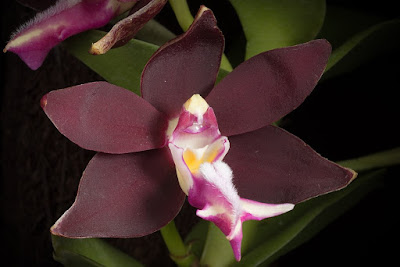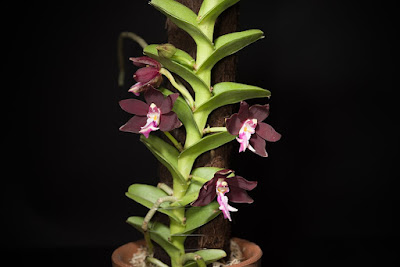Trichoglottis atropurpurea is native to Philippines. These plants are found on the Philippine islands of Mindanao, Leyte, Biliran, Catanduanes, Palawan, and on the south of the island of Luzon...
Trichoglottis atropurpurea also called as The Dark Purple Trichoglottis, Stauropsis philippinensis var. brachiate, Trichoglottis bicruris, Trichoglottis brachiate, Trichoglottis philippinensis var brachiata, is a species of the genus Trichoglottis. This species was described by Heinrich Gustav Reichenbach in 1877.
IDENTIFY TRICHOGLOTTIS ATROPURPUREA
Trichoglottis atropurpurea is native to Philippines. These plants are found on the Philippine islands of Mindanao, Leyte, Biliran, Catanduanes, Palawan, and on the south of the island of Luzon. Their greatest concentration, however, occurs on the island of Mindanao in the provinces of Agusan, Davao and Surigao. They usually grow on tree branches, at low altitudes.
It is a small to large sized, hot growing, epiphytic species, which reaching 30-60 cm long and 0.5-0.8 cm in diameter, with elongated, branching, white roots produced all along the erect, leafy towards the apex stem carrying distichous, coriaceous, oblong to oblong-ovate, retuse, mucronate, carinate, 3-8 cm long, 2.5-4.0 cm wide leaves stem.
The Dark Purple Trichoglottis blooms on an axillary, short, racemose inflorescence with 1 or 2 fragrant, fleshy flowers occurring in the spring and summer. The flowers are 3.0-4.5 cm in diameter, they are variable in color, but the petals of both whorls usually have a vivid, deep red-purple color, and often also have very narrow yellow or whitish objections and in the middle of a sliver of the same color. The hair-covered lip is almost all white, has a few purple streaks at the base, a yellow spot in the middle, and a little red-purple spots at the top.
TRICHOGLOTTIS ATROPURPUREA CARE AND CULTURE
Cultural information should only be used as a guide, and should be to be adapted to suit you. Your physical location; where you grow your plants, how much time you have to devote to their care, and many other factors, will need to be taken into account. Only then can you decide on the cultural methods that best suit you and your plants.
Light:
Trichoglottis atropurpurea needs a light level of 20000-30000 lux. The light should be filtered or dispersed, and the plants should not be exposed directly to the sun in the afternoon hours. Strong air movement should be ensured all the time.
If the plant grows properly, but does not bloom, it may require increasing the level of light. Also, when the sections between the nodes on the stem or leaves are longer than those given in the description or when the leaves are rather soft and delicate, the plant probably does not receive enough light.
Temperature:
It is a thermophilic plant. The average day temperature during the whole year is 29-31 ° C, night 21-22 ° C, which gives a daily amplitude of 8-10 ° C.
Humidity:
The Dark Purple Trichoglottis needs the humidity of 80-85% throughout the year.
Substrate, growing media and repotting:
Trichoglottis atropurpurea are usually grown in hanging pots or battens filled with loose, easily drying substrate. Sometimes, these plants are grown with only a small amount of charcoal or large pieces of bark of the cork oak, so that only keep the plants in the right position. However, it may be necessary to use supports for quite a long momentum. The roots should be allowed to grow and hang freely, and they should not be cut in order to give the plant an orderly appearance.
Watering:
Rainfall is moderate to heavy throughout the year. The cultivated plants should be abundantly watered during active growth, but the roots must always dry quickly after watering. The substrate around the roots can never be desiccated or soggy.
Fertilizer:
During the active growth, the plant should be fertilized every week 1/4-1/2 of the recommended dose of fertilizer for orchids. You can use balanced fertilizer throughout the year, but you can also use fertilizer with increased nitrogen content from spring to mid summer, and then in the late summer and autumn, use a fertilizer with a higher content of phosphorus.
Rest period:
In winter, watering may be somewhat limited, especially in the case of Trichoglottis atropurpurea grown in darker conditions of a short day typical of higher latitudes, but they should not be completely deprived of water. Fertilization should be reduced or eliminated until new growths appear in the spring and more abundant watering starts.















COMMENTS